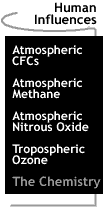
Go to
the "Carbon Dioxide" puzzle piece
for more information about Human Influences on this gas.
Global
Climate Change: Human Influences-- The Chemistry
Global
climate change is a very complex subject. All of
Earth's spheres --the biosphere (living things), hydrosphere (water),
lithosphere (rock/soil), and atmosphere (air)--work together
to create and maintain climate. However, the biosphere, humans
in particular, has had an increasingly greater impact on climate in recent
decades.
One way in which humans have affected the climate is by increasing emissions of greenhouse gases. Greenhouse gases absorb infrared (long-wave, heat) radiation. This is the form of the sun's energy reflected off the earth's surface. Greenhouse gases then radiate heat energy back toward the earth. This heats the earth's atmosphere and ultimately contributes to increasingly warmer climates, a process known as global warming. Common greenhouse gases include carbon dioxide (CO2), chlorofluorocarbons (CFCs), methane (CH4), nitrous oxide (N2O), and tropospheric ozone (O3).
Carbon dioxide (CO2) is a byproduct of the combustion--or burning--of fossil fuels such as coal and oil. Since the Industrial Revolution, humans have burned increasingly greater amounts of fossil fuels for energy. This energy has been used to heat homes, operate automobiles, and power industry. As the practice of burning fossil fuels grows, so does the amount of carbon dioxide emitted to the atmosphere. During the process of combustion, O2 reacts with glucose (C6H12O6, a form of sugar) to produce water and CO2. As the organic matter burns, chemical energy in the form of heat and light is released. The following chemical equation describes the chemical process of combustion:
6 O2 + C6H12O6 --------> 6 H2O + 6 CO2 + energy.
Chlorofluorocarbons (CFCs) are anthropogenic compounds; that is to say they are created by humans. There is no known natural source of these greenhouse gases which contain chlorine, fluorine, and carbon.
Methane (CH4) production--methanogenesis--can occur in a number of ways. The one that may have the largest impact on the climate occurs in freshwater wetlands, such as rice paddies. As the area of land used for rice paddies grows to feed the growing human population, so does the amount of methane it produces. During the microbial metabolic process of methanogenesis, acetate (CH3COOH) is split into CO2 and CH4:
CH3COOH --------> CO2 + CH4.
Nitrous oxide (N2O) is a byproduct of nitrification and denitrification--the natural processes by which NH4+ and NO3-, respectively, are biotically transformed (i.e. changed by microbes). Studies have shown that the use of nitrogen fertilizer on agricultural fields stimulates these processes and thus increases the production of N2O.
Tropospheric ozone (O3), a constituent of smog that irritates the eyes and lungs of many city inhabitants, is a greenhouse gas that can be produced from another greenhouse gas--methane (see above section on the production of methane). This process involves many steps, the net reaction of which is described by the chemical equation:
CH4 + 4O2 --------> HCHO + H2O + 2O3.
Another source of tropospheric ozone is atmospheric nitrate (NO2). First, the nitrate is broken down into nitric oxide (NO) and a single atom of oxygen (O):
NO2 + sunlight --------> NO + O;
then, the atom of O combines with a molecule of O2 to produce O3:
O + O2 --------> O3.
The net reaction, which is in equilibrium (i.e. it goes back and forth), is:
NO2 + O2 <--------> NO + O3.
Overview
..|..
Human
Influences
..|..
Impacts
Atmospheric
CFCs / Atmospheric Methane / Atmospheric
Nitrous Oxide / Tropospheric Ozone
/ The Chemistry
Glossary ..|..
Related
Links ..|..
References
|..
PBL
Model
Home ..|.. Teacher Pages ..|.. Modules & Activities
HTML code by Chris
Kreger
Maintained by ETE
Team
Last updated November 10, 2004
Some images © 2004 www.clipart.com
Privacy Statement and Copyright © 1997-2004 by Wheeling Jesuit University/NASA-supported Classroom of the Future. All rights reserved.
Center for Educational Technologies, Circuit Board/Apple graphic logo, and COTF Classroom of the Future logo are registered trademarks of Wheeling Jesuit University.

